Seventy-five years ago, if you wanted to see the most exciting radio and TV show, all you had to do was go to your nearby Motorola dealer. This ad appeared in Life magazine 75 years ago today, October 17, 1949.

Seventy-five years ago, if you wanted to see the most exciting radio and TV show, all you had to do was go to your nearby Motorola dealer. This ad appeared in Life magazine 75 years ago today, October 17, 1949.
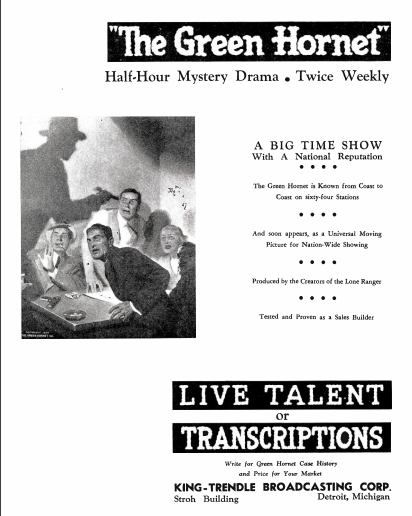 Eighty-five years ago today, the October 15, 1939, issue of Broadcasting magazine carried this ad for the Green Hornet. The radio program had originated three years earlier on Detroit station WXYZ, and was carried on various networks over the years. This ad indicates that it was in syndication in 1939, with its roots still in Detroit. The ad promised a movie to be released soon, and it was indeed serialized in the 1940s.
Eighty-five years ago today, the October 15, 1939, issue of Broadcasting magazine carried this ad for the Green Hornet. The radio program had originated three years earlier on Detroit station WXYZ, and was carried on various networks over the years. This ad indicates that it was in syndication in 1939, with its roots still in Detroit. The ad promised a movie to be released soon, and it was indeed serialized in the 1940s.
The Green Hornet was actually the great nephew of the Lone Ranger, who also got his start on WXYZ.
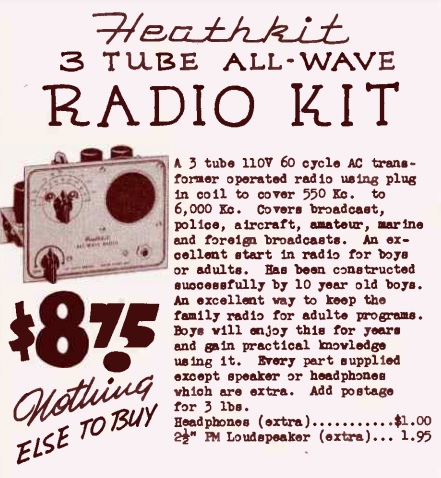 Shown here from 75 years ago is the Heathkit All-Wave Radio. While the ad does not specify the model number, it is the Model K-2, which had recently replaced the similar K-1 which came out the previous year. The set runs on AC power, using one 1626 triode as the rectifier, and a second 1626 as regenerative detector. The 12A6 amplifies the audio to power either headphones or speaker (the only components you need to buy separately, as everything else is included).
Shown here from 75 years ago is the Heathkit All-Wave Radio. While the ad does not specify the model number, it is the Model K-2, which had recently replaced the similar K-1 which came out the previous year. The set runs on AC power, using one 1626 triode as the rectifier, and a second 1626 as regenerative detector. The 12A6 amplifies the audio to power either headphones or speaker (the only components you need to buy separately, as everything else is included).
There’s a very informative article at the Orange County Amateur Radio Club website by AF6C. At that site, you can find a schematic and more information. The ad shown here is from Heath’s October 1949 flyer. The ad notes that the set can be built by either adults or boys–it apparently didn’t occur to them that a girl might want to build one. It had been successfully constructed by 10 year old boys and was billed as a great start in radio. Boys would enjoy it for years, and it had the added benefit of keeping the family radio for adult programs, while Junior listened to what he wanted.
It covered 550 kHz to 6 MHz, apparently with a single plug-in coil. It sold for $8.75 plus shipping, which works out to $115.73 in 2024 dollars. But chances are, Mom and Dad would be willing to cash in a war bond if it meant freeing up the family radio.
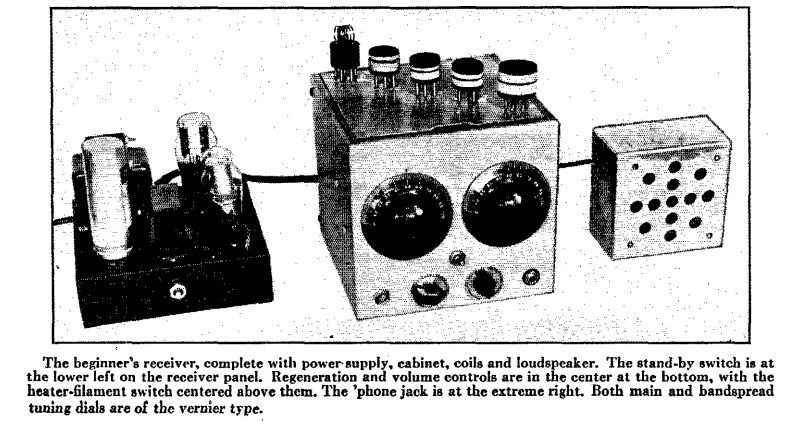 Eighty years ago this month, the October 1944 issue of QST showed how to build this two-tube regenerative receiver. The set was a good performer. The pentode detector provided great sensitivity, and the pentode audio amp was enough to drive a small speaker, or headphones. It even featured a volume control that, while not absolutely necessary, would prove helpful if you wanted to listen with headphones.
Eighty years ago this month, the October 1944 issue of QST showed how to build this two-tube regenerative receiver. The set was a good performer. The pentode detector provided great sensitivity, and the pentode audio amp was enough to drive a small speaker, or headphones. It even featured a volume control that, while not absolutely necessary, would prove helpful if you wanted to listen with headphones.
Plug-in coils covered the broadcast band up to 32 MHz, and the article boasted that, unlike many similar designs, a single coil would cover the entire broadcast band.
The magazine cover boasted that you could laugh at wartime parts shortages. The articles was a little unclear as to exactly how, but it was probably due to the fact that you could substitute various tubes. The set could be built for use on AC power, or with a 90 volt B battery.
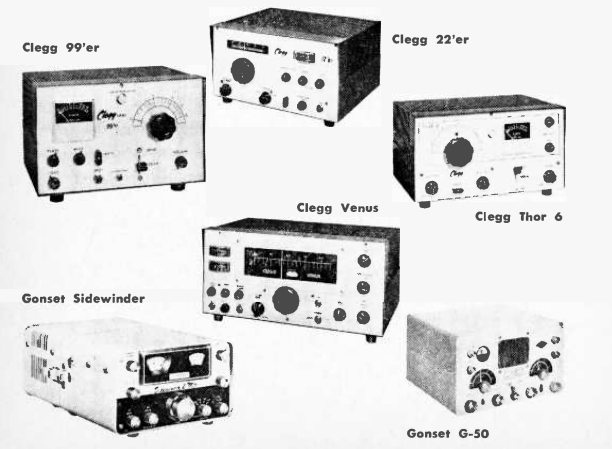 Sixty years ago this month, the October 1964 issue of Radio Experimenter reviews the large number of 6 and 2 meter transceivers available to the ham. The article is penned by Tom Kneitel. He begins by noting that even those who view CB radio as a blight on society have to admit that there was a bright side. The concept of the transceiver–a combination transmitter and receiver–predated the CB craze. But the idea really caught on after CB manufacturers started cranking them out.
Sixty years ago this month, the October 1964 issue of Radio Experimenter reviews the large number of 6 and 2 meter transceivers available to the ham. The article is penned by Tom Kneitel. He begins by noting that even those who view CB radio as a blight on society have to admit that there was a bright side. The concept of the transceiver–a combination transmitter and receiver–predated the CB craze. But the idea really caught on after CB manufacturers started cranking them out.
Hams were the beneficiaries, since the article gave details of many such units in production, from manufacturers such as Clegg, Gonset, Heath, Lafayette, Olson, Utica, and World Radio.
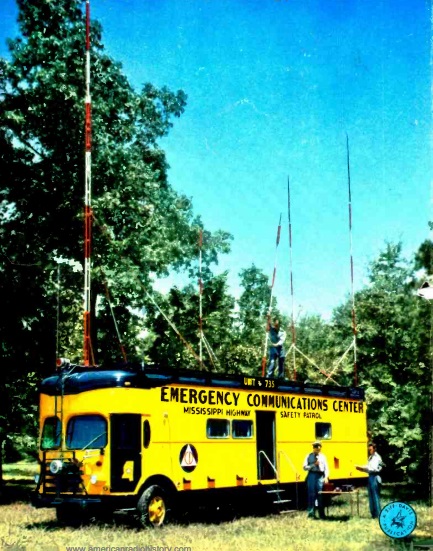 Seventy years ago, the Mississippi Highway Safety Patrol and Civil Defense Council operated this state-of-the-art mobile communications center. The need for such a facility had been shown by recent disasters such as the Gulf Coast hurricane of 1949, the severe ice storm of 1951, and the December 1953 Vicksburg tornado.
Seventy years ago, the Mississippi Highway Safety Patrol and Civil Defense Council operated this state-of-the-art mobile communications center. The need for such a facility had been shown by recent disasters such as the Gulf Coast hurricane of 1949, the severe ice storm of 1951, and the December 1953 Vicksburg tornado.
The state’s basic police radio network consisted of nine 3000 watt stations, and this one would be the tenth, ready to roll at 60 MPH to wherever disaster struck. In addition to the state radio, the van was equipped with VHF low-band and high-band stations, complete with crystals for local departments. At the scene of the disaster, the correct crystals could be installed, and that station manned by personnel from that department. The van included a conference room and bunkroom with six bunks. A power generator was in a trailer. With the exception of the antennas, everything was operational while in motion.
The amateur station consisted of a Johnson Viking 2 transmitter and National NC-125 receiver. Six separate booths were available for the radio operators.
The photo is from the cover of Radio News, October 1954.
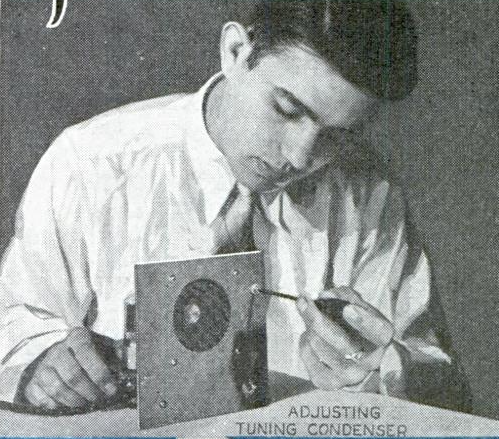 Eighty-five years ago, this young man is making the final tuning adjustments for the one-tube radio he built from plans in the October 1939 issue of Popular Mechanics.
Eighty-five years ago, this young man is making the final tuning adjustments for the one-tube radio he built from plans in the October 1939 issue of Popular Mechanics.
The set was simplicity itself, but it boasted a loudspeaker and AC power, so there was no need to mess around with headphones or a B battery. It was really a crystal set, with a fixed crystal detector. The single tube was a 25A7GT, which combined a pentode AF amplifier with a rectifier. Of course, it had a hot chassis and the familiar “curtain burner” cord to power the filaments.
It was best suited to tune permanently to the same local station. It wouldn’t tune the entire broadcast band without changing the fixed capacitor in parallel with the tuning capacitor, and tuning was very broad. But if you wanted to listen to a local station with loudspeaker volume, the simple design couldn’t be beat.
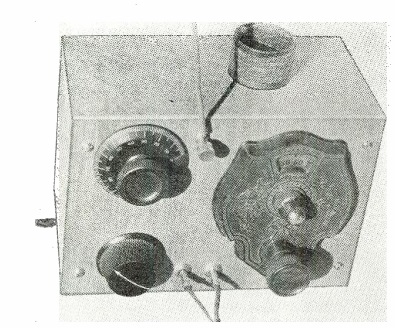 Eighty-five years ago this month, the September 1939 issue of Radio Craft carried the plans for this receiver, which the magazine dubbed the tiniest ham receiver.
Eighty-five years ago this month, the September 1939 issue of Radio Craft carried the plans for this receiver, which the magazine dubbed the tiniest ham receiver.
The three-tube (including rectifier) set had a regenerative detector and one stage of audio amplification to drive a set of headphones. It tuned 9.5 through 700 meters with a set of six coils, meaning that it tuned the entire shortwave spectrum, the broadcast band, and could even pull in SOS calls on 600 meters (500 kHz).
As with many of these designs, it featured a hot chassis, so care must be taken before plugging it in to the power socket.
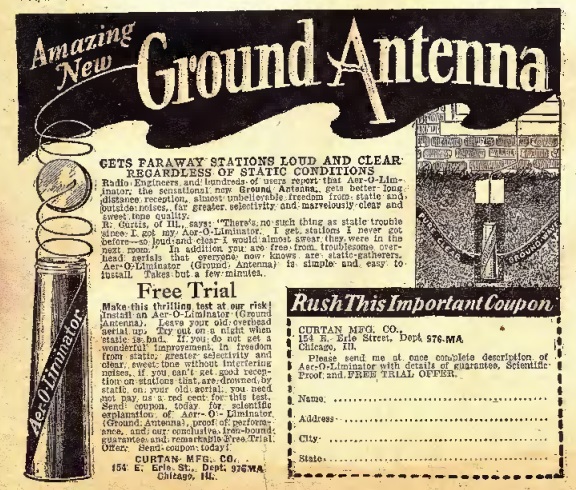 A hundred years ago this month, the September 1924 issue of Amazing Stories carried this ad for an amazing product, namely this underground antenna from the Curtan Mfg. Co., 154 E. Erie Street, Chicago, the Ground Antenna promised loud and clear reception, regardless of static conditions. You would get better long-distance reception, freedom from static, far greater selectivity, and marvelously clear and sweet tone.
A hundred years ago this month, the September 1924 issue of Amazing Stories carried this ad for an amazing product, namely this underground antenna from the Curtan Mfg. Co., 154 E. Erie Street, Chicago, the Ground Antenna promised loud and clear reception, regardless of static conditions. You would get better long-distance reception, freedom from static, far greater selectivity, and marvelously clear and sweet tone.
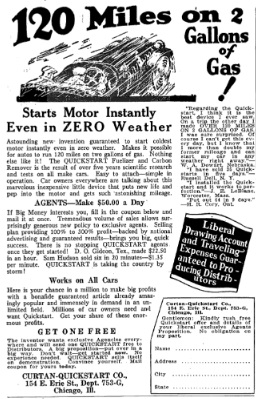 By writing to the company, you would get more details of their risk-free trial offer. It seems like a safe bet. If you decided it wasn’t living up to the promises, you probabaly had to go outside and dig it up to get your money back. This was probably safer for the company than its earlier endeavor, shown in the 1927 ad shown here from National Republic magazine. That miraculous product promised 120 miles on a gallon of gas, as well as instant starts in zero degree weather.
By writing to the company, you would get more details of their risk-free trial offer. It seems like a safe bet. If you decided it wasn’t living up to the promises, you probabaly had to go outside and dig it up to get your money back. This was probably safer for the company than its earlier endeavor, shown in the 1927 ad shown here from National Republic magazine. That miraculous product promised 120 miles on a gallon of gas, as well as instant starts in zero degree weather.
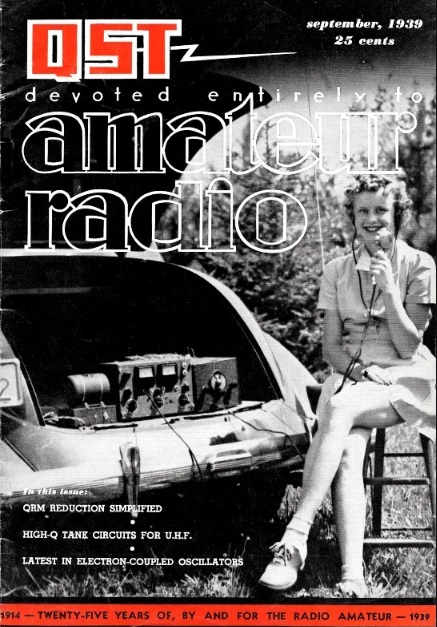 Shown here, on the cover of QST for September 1939, is the portable/mobile ten-meter station of Harold Bowen, W1DQ. According to the magazine, at the microphone is his unnamed assistant operator.
Shown here, on the cover of QST for September 1939, is the portable/mobile ten-meter station of Harold Bowen, W1DQ. According to the magazine, at the microphone is his unnamed assistant operator.
The details of his station aren’t given, but since the unit on the right has a dial, it’s undoubtedly the receiver, with the transmitter being in the middle. The unit on the left is unmistakably a dynamotor power supply.
According to this family history, Bowen was a World War 1 veteran, having been in charge of communications on the U.S.S. DuPont. He died in 1973, according to this obituary.